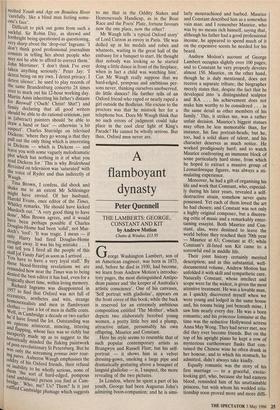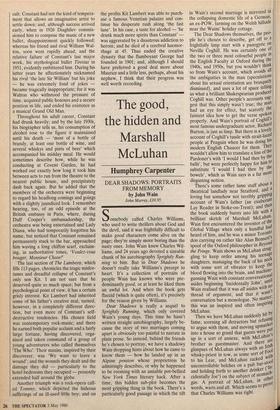A flamboyant dynasty
Peter Quennell
THE LAMBERTS: GEORGE, CONSTANT AND KIT by Andrew Motion
Chatto & Windus, .£13.95
George Washington Lambert, son of an American engineer, was born in 1873, and, before he died in 1930, had become, we learn from Andrew Motion's introduc- tory pages, the most distinguished Antipo- dean painter and 'the keeper of Australia's artistic conscience'. One of his canvases, 'Self portrait with gladiolae', appears on the front cover of this book; while the back is reserved for an extremely ambitious composition entitled 'The Mother', which depicts two elaborately berobed young women, a pretty little boy and a plump, attractive infant, presumably his own offspring, Maurice and Constant. Here his style seems to resemble that of such popular contemporary artists as Brangwyn and Russell Flint; but his self- portrait — it shows him in a velvet dressing-gown, smoking a large pipe and dramatically gesturing above a bouquet of languid gladiolae — is, I suspect, the more revealing of the two pictures. In London, where he spent a part of his youth, George had been Augustus John's admiring boon-companion; and he is simi- larly moustachioed and barbed. Maurice and Constant described him as a somewhat vain man: and I remember Maurice, who was by no means rich himself, saying that, although his father had a good professional income, he appeared to spend much of it on the expensive scents he needed for his beard.
Andrew Motion's account of George Lambert occupies slightly over 100 pages; and to Constant he very properly devotes almost 150. Maurice, on the other hand, though he is duly mentioned, does not receive a separate tribute; the biographer merely states that, despite the fact that he developed into 'a distinguished sculptor and RA . . . his achievement does not make him worthy to be considered . . . in the same detail as other members of his family.' This, it strikes me, was a rather unfair decision. Maurice's biggest statues may often be less memorable than, for instance, his fine portrait-heads; but he, too, had a solid share of talent, and his character deserves as much notice. He worked prodigiously hard; and to watch Maurice confronting an immense block of some particularly hard stone, from which he hoped to extract a massive group of Leonardoesque figures, was always a sti- mulating experience.
Moreover, he had a gift of organising his life and work that Constant, who, especial- ly during his later years, revealed a self- destructive strain, somehow never quite possessed. Yet each of them loved the art he had chosen; and Constant was not only a highly original composer, but a discern- ing critic of music and a remarkably enter- taining essayist. Both Maurice and Con- stant, alas, were destined to leave the world before they reached their 70th year — Maurice at 63; Constant at 45; while Constant's ill-fated son Kit came to a sorrowful end in middle life.
Their joint history certainly merited description; and in this substantial, well- documented volume, Andrew Motion has unfolded it with skill and sympathetic care. Naturally Constant, whose intellect and scope were far the widest, is given the most attentive treatment. He was a lovable man, as I quickly discovered myself when we were young and lodged in the same house and, his rooms being just beneath mine, I saw him nearly every day. He was a born romantic; and his princesse lointaine at the time was the seductive Hollywood actress Anna May Wong. They had never met, nor did they ever become friends. But on the top of his upright piano he kept a row of mysterious earthenware flasks that con- tained the Chinese wine he often drank in her honour, and to which his stomach, he admitted, didn't always take kindly.
Equally romantic was the story of his first marriage — to a graceful, exotic- looking girl, who, because she had eastern blood, reminded 'him of his unattainable princess, but with whom his wedded rela- tionship soon proved more and more diffi- cult. Constant had not the kind of tempera- ment that allows an imaginative artist to settle down; and, although success arrived early, when in 1926 Diaghilev commis- sioned him to compose the music of a new ballet, disappointment quickly followed; whereas his friend and rival William Wal- ton, soon went rapidly ahead; and the relative failure of Constant's last major work, his mythological ballet Tiresias in 1951, evidently embittered him. During his latter years he affectionately nicknamed his rival 'the late Sir William' but his joke — he was extremely fond of jokes — became tragically inappropriate; for it was Walton who withstood the pressure of time, acquired public honours and a secure position in life, and ended his existence as a musical Grand Old Man.
Throughout his adult career, Constant had drunk heavily; and by the late 1930s, his biographer tells us, his consumption of alcohol rose to the figure it maintained until his death — 'most of a bottle of brandy, at least one bottle of wine, and several whiskys and pints of beer' which accompanied his midday meal. He would sometimes describe how, while he was conducting at Covent Garden, he had worked out exactly how long it took him between acts to run from the theatre to the nearest public house, and precipitately dash back again. But he added that the members of the orchestra were beginning to regard his headlong comings and goings with a slightly jaundiced look. I remember hearing, too, of an odd episode at the British embassy in Paris, where, during Duff Cooper's ambassadorship, the orchestra was being entertained and Lady Diana, who had temporarily forgotten his name, but noticed that Constant remained permanently stuck to the bar, approached him waving a long chiffon scarf, exclaim- ing, in authoritative tones, `Voulez-vous bouger, Monsieur Chose!'
The last section of The Lamberts, which fills 113 pages, chronicles the .tragic misfor- tunes and dreadful collapse of Constant's only son Kit. I am not sure that he deserved quite so much space; but from a psychological point of view, it has a certain grisly interest. Kit Lambert had inherited some of his father's creative zeal, turned, however, in a completely different direc- tion, but even more of Constant's self- destructive tendencies. His chosen field was contemporary rock-music; and there he earned both popular acclaim and a fairly large fortune, having discovered, orga- nised and taken command of a group of young adventurers who called themselves 'The Who'. Their maxim, inspired by their discoverer, was 'We want to leave a wound'; and the wounds they dealt and the damage they did — particularly to the hotel bedrooms they occupied — presently extended half around the globe.
Another triumph was a rock-opera call- ed Tommy, which depicted the hideous sufferings of an ill-used little boy; and on
the profits Kit Lambert was able to purch- ase a famous Venetian palazzo and con- tinue his desperate rush along 'the fast lane'. In his case, a taste for alcohol — 'he drank much more spirits than Constant' — was aggravated by a disastrous addiction to heroin; and he died of a cerebral haemor- rhage at 45. Thus ended the creative dynasty that the flamboyant George had founded in 1901; and, although I should have preferred a good deal more about Maurice and a little less, perhaps, about his nephew, I think that their progress was well worth recording.



















































 Previous page
Previous page